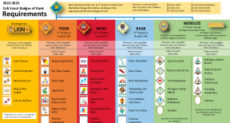 One of the greatest virtues of the Scouting program is that it teaches young people how to solve problems in real time with the resources they have at their disposal. They’re not usually major problems – at least not to us, but to the Scouts, they can befuddle and confuse until they set themselves in the right direction.
One of the greatest virtues of the Scouting program is that it teaches young people how to solve problems in real time with the resources they have at their disposal. They’re not usually major problems – at least not to us, but to the Scouts, they can befuddle and confuse until they set themselves in the right direction.
I recently read an article by Tommy Gray, CPBE, in a broadcast engineering trade magazine. We broadcast engineers often face puzzling problems that need to be resolved quickly. Gray offered the advice that you are never totally down if you use your head. There are three things to keep in mind, in his “Engineering Recovery Philosophy”. These are:
- Start where you are
- Use what you have
- Do what you can!
Coupled with Baden-Powell’s admonition (our motto) to Be Prepared (for any old thing, he elaborated), these three steps can be a powerful aid to setting your mind straight amid a setback or a conundrum.
It’s not possible to be prepared for every “any old thing,” but you and your Scouts can be reasonably well prepared. Part of this process is the collective learning that has taken place through the life of the troop. Along the way, issues may crop up – tents that start to leak, stoves that won’t light – issues that Scouts who have been around for a while may have encountered and learned how to overcome.
For a new-Scout patrol, a sudden rain shower that drenches outerwear prompts discovery of a way to dry jackets, and a clothesline gets put up. The quartermaster thought ahead to bring the rope and knowing the proper knots to use allowed the Scouts to string a clothesline between the trees.
They followed the three-step recovery philosophy without even realizing it: They started where they were (wet clothes), used what they had (trees and rope) and did what they could (put up a clothesline).
Taking it a step further, the committee can use the three steps as a way to help themselves over obstacles. From finding people to do important functions to finding ways to carry out the Scouts’ plans, having the available resources in mind and at hand is key to resolving your problems.
When a problem crops up or there’s a task to do, start where you are. Use what you have – knowledge, tools resources – and do what you are able to do (this means asking others for help too), and you’ll find you have a grip on the situation.
Image: zdiviv / freedigitalphotos.net
This post first appeared on Bobwhite Blather.




Such a timely post! Our Troop just participated in the Annual Klondike Derby. The Scouts did pretty well until the last challenge “build a fire and cook a hard boiled egg in a paper cupâ€. Certainly one of those “use what you can†moments. Us scouters had 50 yardline seat at the station. The fire was easy but the cooking resulted in great discussion and debate. The scouts did not have the confidence to put the cup full of water right in the fire. They rigged the cup on some wood which seemed to be working until the fire shifted, the cup fell over, and quickly burned to ash. A great display of trial by fire and a lesson learned. Just wait til next time!
Thanks for the great story, Jim! Think of the advantages these young men will have when they’re working on a lab experiment in college, or on a project team for their employer. The situational problem-solving experiences our Scouts gain while they’re out camping with their friends will put them a step ahead in the “real” world. (And the adults stayed on the sidelines – as it should be!)